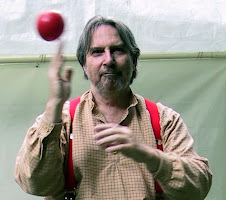I can't get knives sharp.
I can use a steel or whetstone, or even a grinder with moderate proficiency. But I can't get a knife really sharp. By sharp I mean hair-splitting, dry-shaving, samuri cloud-carving sharp.
It's a technology that I've studied somewhat, but the skill or patience or persistence or something just isn't there. It shouldn't be that hard! It's something we've been doing since flint-knapping fell out of use.
There's a medieval weapon maker who I used to see at the Philomath Renfaire. In the front of his stall he displayed a huge two-handed battle blade, in a massive stand that raised the sword above the level children could easily reach. It had a sign underneath saying, "Extremely sharp. Touch at your own risk." Even so, he'd have to come out from the stall periodically to wipe away the blood.
It was a very effective advertisement, if not an effective warning.
I'd like to know how to get a blade that sharp. It's a technology that, for me, borders on wizardry. And that is a point I find very interesting.
The saying goes, "Any sufficiently advanced technology is indistinguishable from magic." The late Arthur C. Clarke, I think. And it's true not only about cutting edge technology, but about archaic edge technology, and many other archaic technologies as well.
As I've said here earlier, that's possibly why we are so attracted by fire, and also why fire performing has become so popular. It's an archaic technology: who uses a wood stove to cook dinner, or candles to see or read by at night? Yet we love campfires and fireplaces. And every city in the US has at least one monthly firejam, and some have several each week. At these events, people spin and dance with fire-poi, staff, meteor, whip, wings, fingers, jump rope, and even fire hula-hoop. Fire is dangerous, of course. It's also self-correcting when we get singed. But it isn't as dangerous as it looks to the uninitiated.
Still, people try to explain it away: "It's stage fire."
It isn't. It's quite real and people do hurt themselves, sometimes quite badly. The techniques that make it relatively manageable and reasonably safe are not that hard to learn, but they are not intuitive, and trial-and-error doesn't work well here. It's an example of cutting-edge archaic technology.
Archaic technology is part of the attraction of steam-punk: Victorian clockwork and steam technology pushed to Jules Vern limits. Two outstanding examples of steam-punk as performance art are the Sultan's Elephant, and the Telectroscope. Their back stories make them all the more real. http://en.wikipedia.org/wiki/The_Sultan's_Elephant, and http://www.telectroscope.org, which also has a nice Wikipedia article.
Just using Google will get you people's home photos, with no story, no mystery, none of the feel essential for experiencing them, so don't go there first. Suspend your disbelief, and experience them in the manner that their creators intended, as a mystery. As magic!
Subscribe to:
Post Comments (Atom)


No comments:
Post a Comment